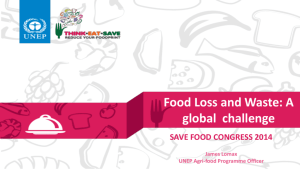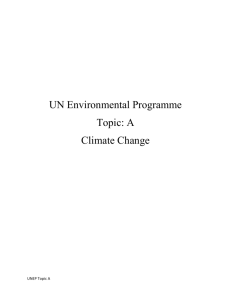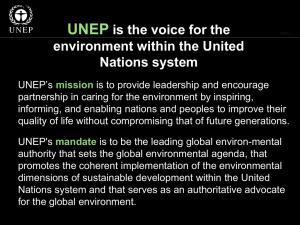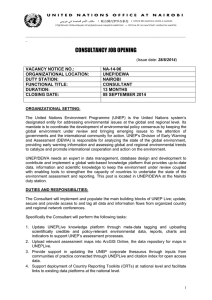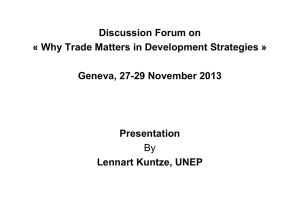Ecological impacts of large scale biomass production systems and
advertisement
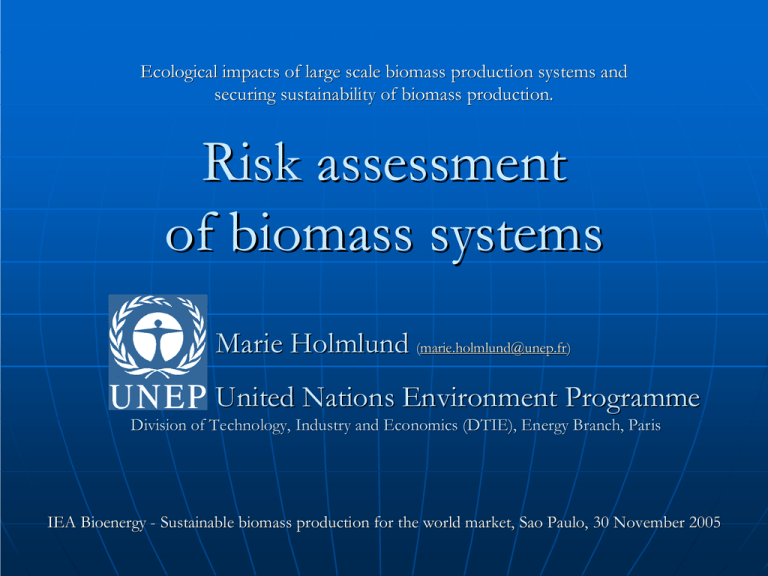
Ecological impacts of large scale biomass production systems and securing sustainability of biomass production. Risk assessment of biomass systems Marie Holmlund (marie.holmlund@unep.fr) marie.holmlund@unep.fr) United Nations Environment Programme Division of Technology, Industry and Economics (DTIE), Energy Branch, Paris IEA Bioenergy - Sustainable biomass production for the world market, Sao Paulo, 30 November 2005 Promoting Renewable Energy 1) Getting the policies right • CD4CDM (www.cd4cdm.org) • Global Network on Energy for Sustainable Development, GNESD (www.gnesd.org) Marie Holmlund, UNEP page 2 (14) Promoting Renewable Energy 2) Mobilising Investment • Biofuel Oil Promotion and Credit Facility • Sustainable Energy Finance Initiative, SEFI (www.sefi.unep.org) • Rural Energy Enterprise Development, REED (www.areed.org, www.b-reed.org, www.c-reed.org) Marie Holmlund UNEP page 3 (14) Partnerships At the Environmental Forum in Magdeburg, Germany, DaimlerChrysler and UNEP agreed to: Promote the establishment of standards for biofuel blends and their promotion through appropriate incentives Explore the development of a “sustainability seal” or criteria for the cultivation of biomass for biofuels Marie Holmlund UNEP page 4 (14) UNEP’s strengths in the bioenergy sector Environmental sustainability Developing countries’ possibilities Financing tools Global perspective Marie Holmlund UNEP page 5 (14) Production potential in developing countries Good conditions regarding soil, climate CDM possibilities Large job creation potential Effective utilization of wasteland areas Increase the tree cover and help control soil erosion Marie Holmlund UNEP page 6 (14) Possible risks involved in large scale bioenergy production Soil degradation and water scarcity Threat to biodiversity Threat that the needs of local populations will be put aside Child/underpaid labour Increased food prices Marie Holmlund UNEP page 7 (14) The Environmental Due Diligence – Risk assessment of biomass system based on energy crops a) Assessing the environmental and social risks and opportunities b) Determining mitigation measures to address the risks c) Determining the costs of managing the risks d) Reporting Marie Holmlund UNEP page 8 (14) The Environmental Due Diligence – Risk assessment of biomass system based on energy crops 1. Effluent emissions, on-site contamination and hazardous materials issues Use of pesticides Use of chemical fertilisers Brownfield location Emissions of NOx, SO2, CO, particulates, VOC, GHG Solid waste Marie Holmlund UNEP page 9 (14) The Environmental Due Diligence – Risk assessment of biomass system based on energy crops 2. Biodiversity protection issues introduction of non-native species use of GMOs Marie Holmlund UNEP page 10 (14) The Environmental Due Diligence – Risk assessment of biomass system based on energy crops 3. Workers health and safety issues Pesticide application Risk of accidents from crop cultivation and harvesting (poisoning, fires etc) Risk of accidents from generation activities Marie Holmlund UNEP page 11 (14) The Environmental Due Diligence – Risk assessment of biomass system based on energy crops 4. Environmental issues sensitive to public opinion significant land use www.sefi.unep.org soil erosion or compaction water depletion loss of biodiversity visual impact noise from generation activities Marie Holmlund UNEP page 12 (14) Final remarks Need for: Assured sustainable large scale production The right policies and regulations Infrastructure in place Knowledge transfer including a learning network among developing countries Environmental ‘foresight’ Marie Holmlund UNEP page 13 (14) Not a local issue This little planet = our home Marie Holmlund UNEP page 14 (14)

